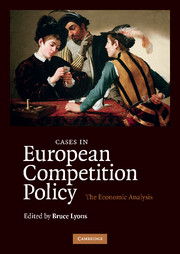Book contents
- Frontmatter
- Contents
- Contents by potentially anticompetitive business practices
- Contents by markets
- List of figures
- List of tables
- List of contributors
- Preface
- Introduction: the transformation of competition policy in Europe
- A Anticompetitive behaviour by firms with market power
- B Agreements between firms
- Introduction
- B.1 Cartels
- 5 The graphite electrodes cartel: fines which deter?
- 6 Assessment of damages in the district heating pipe cartel
- B.2 Other horizontal agreements
- B.3 Vertical agreements
- C Mergers
- Bibliography
- Index
6 - Assessment of damages in the district heating pipe cartel
Published online by Cambridge University Press: 05 June 2012
- Frontmatter
- Contents
- Contents by potentially anticompetitive business practices
- Contents by markets
- List of figures
- List of tables
- List of contributors
- Preface
- Introduction: the transformation of competition policy in Europe
- A Anticompetitive behaviour by firms with market power
- B Agreements between firms
- Introduction
- B.1 Cartels
- 5 The graphite electrodes cartel: fines which deter?
- 6 Assessment of damages in the district heating pipe cartel
- B.2 Other horizontal agreements
- B.3 Vertical agreements
- C Mergers
- Bibliography
- Index
Summary
Introduction and motivation
Following a complaint by Swedish competitor Powerpipe, the European Commission paid a surprise visit to nine producers of pre-insulated pipes for district heating systems and their trade association on 28 June 1995. The EU Commission found detailed evidence that the companies had conspired to share markets, fix prices and rig bids in various markets during the period 1990–6 and that they had attempted to eliminate Powerpipe by organising a boycott of suppliers. Powerpipe had resisted invitations to join the cartel and had won several contracts that cartel members had allocated amongst themselves. According to the decision of the EU Commission taken on 21 October 1998, the cartel continued to operate for nine months after the dawn raid. The European Commission decided to impose fines totalling €92.21 million to the ten members of the cartel. In March 2002, the Court of First Instance reduced the fines by €5.1 million but upheld the decision of the EU Commission in broad terms. All but one firm (viz. Sigma) appealed this decision to the European Court of Justice, which dismissed the appeals on 28 June 2005.
In European competition policy fines are issued by the European Commission as a penalty for illegitimate behaviour (anticompetitive agreements or abuse of dominance) with the aim of discouraging such behaviour in the future. The fines contribute to the budget of the European Communities and hence do not compensate the victims of the behaviour.
- Type
- Chapter
- Information
- Cases in European Competition PolicyThe Economic Analysis, pp. 159 - 176Publisher: Cambridge University PressPrint publication year: 2009



